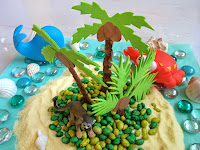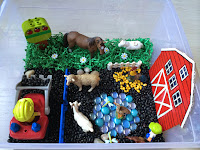Today we explored our next habitat – a desert. I used semolina instead of sand in this bin. My daughter loves this ingredient and I use it a lot even though it is very messy and our floors require some cleaning by the end of the game. You can draw letters and numbers with your fingers on semolina. You can hide little animals in it and ask you child to find them or make animal footprints and ask your child to guess the animal.
Talk about hot desert climate, show your child some animals and insects that live there and tell him/her how they were able to adapt to severe heat and lack of water supply. You can also show pictures of the biggest desert, Sahara, sand dunes and camel trains.
I made a lizard and a scorpion out of foil and painted them with acrylics. Cactuses are cut out of foam sheets.
My other sensory bins with animal habitats:
African Swamp Sensory Bin
Forest Sensory Bin
African Swamp Sensory Bin
Indian and Indonesian Jungle Sensory Bin
Tropical Island Sensory Bin
Farm Sensory Bin
Coral Reef Sensory Bin
Frog Pond Sensory Bin
Arctic Sensory Bin
Ocean Life Sensory Bin
Talk about hot desert climate, show your child some animals and insects that live there and tell him/her how they were able to adapt to severe heat and lack of water supply. You can also show pictures of the biggest desert, Sahara, sand dunes and camel trains.
I made a lizard and a scorpion out of foil and painted them with acrylics. Cactuses are cut out of foam sheets.
My other sensory bins with animal habitats:
African Swamp Sensory Bin
Forest Sensory Bin
African Swamp Sensory Bin
Indian and Indonesian Jungle Sensory Bin
Tropical Island Sensory Bin
Farm Sensory Bin
Coral Reef Sensory Bin
Frog Pond Sensory Bin
Arctic Sensory Bin
Ocean Life Sensory Bin
African Savannah Sensory Bin














No comments:
Post a Comment